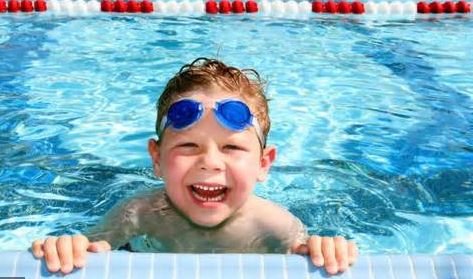
The warmer months are just around the corner, and with them are more opportunities to cool off in the water. Pool preparedness, such as swimming lessons, are essential for a safe and enjoyable summer. According to a 2010 statistic from the CDC, drowning is a leading cause of deaths in children between 1 and 4 years old, second only to congenital diseases. This year, be sure to beat the heat and stay safe by teaching your young guppies how to safely tread water (even in shallow depths).
Toddler-Appropriate Tips
Due to the high quantity of swimming-related accidents, parents are encouraged to begin providing swimming lessons while the children are toddlers. During these years, lessons are geared towards the child’s enjoyment of water. Playing games in the pool will get children more comfortable in the water while teaching them basic water safety techniques.
Sit in the shallow end together and splash around. Have the children lower their heads and blow bubbles. If a pool is unavailable, begin these basic steps and games in the bathtub. Always be present since water safety starts first and foremost with adult engagement and supervision.
Tips for Children between the Ages Of 4-8
By 4-5 years of age, children should feel more confident in the water. This is a good time to teach floating, gliding, and practice kicking. Parents or adults can help by spotting them, turning each lesson into an opportunity for fun and easing anxiety.
Teach floating by letting the children lay across your arms in the water. Encourage them to relax and focus on their breathing. Slowly submerge your arms into the water. Don’t remove them immediately, but give the child a chance to experience having the water creep around their faces and feeling weightless, while also knowing that you are by their side.
Gliding can be a fun way to ease into floating. Ask children to hold the side of the pool, with their back to the center, knees at their chest, and feet against the side of the pool. Then have them gently push away from the side with their feet and relax on their back. Children should also practice gliding on their stomachs.
Practice kicking by holding stairs or the pool edge. Slowly the child can release one hand, then both and push away from the pool edge. Always keep an eye on them.
Engaging Kids
Teaching kids to swim is important, and they should all know some basics, even if you don’t go to the pool often, or even if they don’t like swimming. IF you are having trouble getting kids into the water address their fears calmly. See if playing with small submergible toys or interactive wear like Shimmer Tail can work to draw their interest. Give them a chance to see what swimming is all about and have them excited before you start giving a lesson.
No matter which way you choose to teach young children the basics, always remember to be present and positive.


